
Furuno CAN bus Network Design Guide
1
Furuno CAN bus Network Design Guide
This document describes the Furuno CAN bus and shows how to create Furuno CAN bus
networks and how to install Furuno CAN bus devices.
1. What is Furuno CAN bus?
Furuno CAN bus devices comply with NMEA 2000 physical and protocol standards, but these
devices can be installed in a slightly different way from the NMEA2000 standard to make a
network creation easier.
NMEA 2000
NMEA 2000 is a combined electrical and data specification for a marine data network for
communication between marine electronic devices such as depth finders, chartplotters, navigation
instruments, engines, tank level sensors and GPS receivers. NMEA 2000, a successor to the NMEA
0183 standard, connects devices using CAN (Controller Area Network) technology originally developed
for the automotive industry. CAN based networks were developed to function in electrically noisy
environments.
NMEA 2000 vs. NMEA 0183
NMEA 2000 is a serial data “network” operating at 250k bps and NMEA 0183 is a serial data “interface”
operating at 4.8k bps. NMEA 2000 networks allows multiple electric devices to be connected together
on a common channel for the purpose of easily sharing information.
Table 1 NMEA 2000 vs. NMEA 0183
NMEA 2000
NMEA 0183
Connector Standard
connectors
(Plug and play)
Different connectors of each
manufacturer
Data rate
250k bits/second
4.8k (38.4k) bits/second
Compact binary message
ASC II serial communication
Multi-talker, multi-listener
Single-talker, multi-listener
Protocol
Network Serial
communication
(Point to point communication)
CAN vs. Ethernet
NMEA decided to choose CAN to develop a low-cost, self-configuring, and multi-master network. The
table below shows other advantages of CAN over Ethernet.
Table 2 CAN vs. Ethernet
CAN
Ethernet
Power Consumption
Lower
Higher
Bandwidth Low
High
Collision Avoidance
Yes
No avoidance
(Collision detection)
Message Priority
Yes
No
Pub. No. TIE-00170-B
















